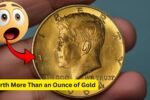This $2 Bill from 1976 Could Be Your Fortune: Most people see a $2 bill and think it’s just another piece of money. But if you have one from 1976, it might be worth a lot more than two dollars. These bills were released to celebrate the United States’ 200th birthday, and while they were common back then, some of them have become rare and collectible today. If you’ve got one lying around, it could turn out to be a small treasure.
Why Was the 1976 $2 Bill Special?
The 1976 $2 bill was reintroduced by the U.S. Treasury to mark America’s Bicentennial celebration. Before that, the $2 bill had not been printed since 1966. To make this bill stand out, the back featured a famous painting called “The Signing of the Declaration of Independence” instead of the usual design. That alone makes it more interesting to collectors. While many people didn’t take these bills seriously at the time and just kept them as souvenirs, their rarity today has made them more valuable.
What Makes Some 1976 $2 Bills More Valuable Than Others?
Not all 1976 $2 bills are worth a fortune, but certain details can raise their value. If the bill is uncirculated, meaning it has never been used or folded, it’s likely worth more. Also, bills with rare serial numbers or those with printing errors can be especially valuable. For example, if the serial number is very low (like starting with 00000001), or if it’s a repeating or “fancy” pattern (such as 12344321), collectors may be willing to pay a premium for it. Bills that were part of limited runs, or those marked as “star notes” – which replace misprinted bills – can also fetch a higher price.
How to Check If Your 1976 $2 Bill Is Worth More?
Start by carefully looking at the bill. Check its condition first. If it looks crisp and new, it’s probably in uncirculated condition. Then look at the serial number, which is the long number in green ink printed twice on the front. Unique patterns or low numbers are what collectors look for. Also, check if there’s a star at the beginning or end of the serial number – that’s a “star note.” Lastly, find out which Federal Reserve Bank issued the bill by checking the letter and number on the seal; some banks printed fewer bills, making those more rare.
Real Value of a 1976 $2 Bill: What Collectors Pay Today
While a regular 1976 $2 bill in average condition might only be worth $2, others can be worth much more. For example, an uncirculated bill could be worth between $10 and $30. A star note in perfect condition might go for $50 or even higher. If the bill has a rare serial number or printing mistake, it could fetch hundreds of dollars at an auction or from a serious collector. The market value depends on supply, demand, and how many people want that specific kind of bill.
Here’s a Quick Look at the Values Based on Features
| Feature | Approximate Value |
|---|---|
| Circulated (average condition) | $2 |
| Uncirculated condition | $10 – $30 |
| Star Note (Uncirculated) | $20 – $70 |
| Fancy Serial Number | $50 – $500+ |
| Printing Error | Varies (can be $100s) |
| Very Low Serial Number | $100 – $1000+ |
Should You Sell or Hold On To It?
If you have a 1976 $2 bill and it looks like it might be special, it could be worth getting it appraised by a currency expert. You can also check online auction sites like eBay to see how similar bills are priced. If the bill is not too valuable right now but is in great condition, you might consider holding onto it. As time passes, the value could increase even more, especially as fewer of these bills remain in good condition.
Where Can You Sell a 1976 $2 Bill?
You can sell these bills in various places. Online marketplaces like eBay, Etsy, or dedicated currency collector forums are popular choices. Some coin and currency shops will buy them directly if they see value in your bill. You can also attend collector shows or fairs where you might find people willing to pay a premium for rare bills. Just make sure to research your bill’s worth first so you know if you’re getting a fair deal.
Final Thoughts: Don’t Underestimate That Old $2 Bill
It might seem strange to think of a $2 bill as something valuable, but the 1976 version has a special place in U.S. currency history. Because of its unique design and limited use, it has become a favorite among collectors. Yours might be worth just face value, or it might be a hidden gem. Either way, it’s worth taking a closer look—you never know what fortune could be sitting in your wallet or drawer.
FAQs About the 1976 $2 Bill
Q: Are all 1976 $2 bills valuable?
No, most are still only worth $2, but some can be worth much more depending on condition and rarity.
Q: How can I tell if my $2 bill is rare?
Look for unique serial numbers, a star symbol, excellent condition, or any printing mistakes.
Q: Is it legal to use the 1976 $2 bill today?
Yes, it is still legal tender and can be used just like any other bill, though most people save them.
Q: What does a star note mean?
A star note replaces a misprinted bill during production. These are rarer and often more valuable.
Q: Should I keep my $2 bill or sell it?
If it’s rare or in mint condition, consider keeping it or getting it appraised. Otherwise, it’s up to you.




